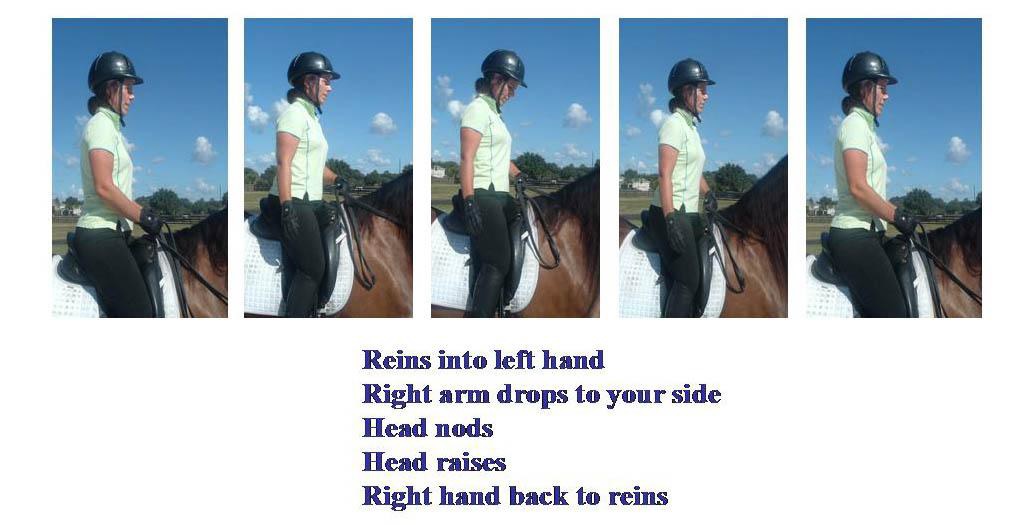If your judge penalized you for an error, most likely you were nervous and forgot to take your reins in one hand. That is an absolute requirement whether you are male or female—it’s written in the Rulebook. If you didn’t get a “minus two,” your salute probably wasn’t illegal, just unsightly.
There are a few ways to fulfill the saluting obligation that conform to the rules and to dressage etiquette.
If you are blessed not to possess the Y chromosome, here’s how your salute should work. Job number one is to make an actual halt, that is, make your horse be immobile (if there’s any prayer of that) before you begin the salute. If you recognize that this condition is, for the moment, beyond your horse’s abilities, pretend that it happened and carry on.
It is permissible to salute with either hand; so take the reins—all two or four of them—in your other hand. This hand’s job is to continue riding the horse throughout the rest of the process. The hand holding the reins keeps him straight, planted at X, and—should fortune smile upon you—on the bit.
Next comes a little four step routine: 1) Drop your free hand by your side; 2) keeping your body erect, drop your head downward; 3) raise your head; 4) take the reins back in “riding” position.
Then depending on your horse’s level, either move off into trot fluidly through the walk or directly to an active trot. If this is the final halt at the test’s conclusion, take a few walk steps forward, make a smooth half circle to the rail in either direction, and make your way on long reins to the exit. Personally, I walk along the rail to about P or V and then take a diagonal line to the gate. For a while, it was fashionable, particularly among event riders, to walk the track to A and make a 10 meter circle before leaving. For God’s sake, DON’T DO THIS! You are not in the Olympics. The adoring throngs are not cheering wildly. The judge will be perfectly happy to watch you leave conventionally and to blow her whistle for the next rider.
Meanwhile, if you’re a guy, you’re permitted to salute exactly the same way. And if you’re wearing a helmet with a chinstrap, you really don’t have any choice. If you happen to be wearing a regular old hunt cap (or a derby that makes you look goofy or a top hat), the routine is still a four step one. Instead of dropping an empty hand by your side, the hat goes down there with the crown facing out and the inside (where your head would go) facing the horse’s side. It is considered déclassé to hold your hat downward, inner aspect forward, as though you’re expecting a donation from the judge. Since you’re already doing this elaborate bit with the hat, you may either acknowledge the judge with a downward nod of your head or (if you’re feeling an especially strong testosterone rush) simply subject the judge to your steely gaze and dare her to give you anything less than an 8!
The only time a military salute is appropriate is if the rider is in uniform, usually military or police. I once judged a hyper-enthusiastic ex-scoutmaster in a Boy Scout uniform, and he rendered a military sort of salute. It happened so quickly that I didn’t have time to count how many fingers he used.
A few additional thoughts: 1) Make your salute and move on. Don’t wait for the judge to acknowledge it. He does not need to, and even if he does, you may miss it while you’re looking down. 2) If you’re carrying a whip, it’s best to have it in the hand that’s going to hold the reins, not the saluting one. Waving the whip around down by your horse’s side can have a tendency to interfere with an otherwise obedient halt. And 3) Don’t “go exotic”: No flourishes, no bowing from the waist, no flapping your saluting arm out to the side.
Following these pointers should, if nothing else, reduce your likelihood of becoming fodder for the judges’ conversation over dinner.
 Thanks to Susan Mori and Jaranero, PRE, (pictured above) for their help!
Thanks to Susan Mori and Jaranero, PRE, (pictured above) for their help!
